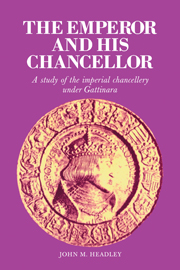Book contents
- Frontmatter
- Contents
- Acknowledgments
- List of abbreviations
- Introduction
- 1 The administrative threshold
- 2 The emerging government of Charles V
- 3 The conflict between chancellor and emperor
- 4 The imperial chancellery
- 5 The imperial propaganda campaign of 1526–1527
- 6 The last years of the chancellorship
- Epilogue
- Appendix 1 The Summary by Philippe Hanneton, audiencier of the Burgundian chancellery, regarding the office of the Grand Chancellor
- Appendix II ‘The Doubts of [Alonso de] Soria’, lieutenant protonotary, concerning Gattinara's proposals for reforming the Aragonese chancellery
- Appendix III Gattinara's ‘Brussels Remonstrance’
- Appendix IV Gattinara's proposals for the more effective operation of the Council of State
- Appendix V A comparative analysis of the movements of the imperial court and the imperial chancellery 1518–1530
- Bibliography
- Index
- Frontmatter
- Contents
- Acknowledgments
- List of abbreviations
- Introduction
- 1 The administrative threshold
- 2 The emerging government of Charles V
- 3 The conflict between chancellor and emperor
- 4 The imperial chancellery
- 5 The imperial propaganda campaign of 1526–1527
- 6 The last years of the chancellorship
- Epilogue
- Appendix 1 The Summary by Philippe Hanneton, audiencier of the Burgundian chancellery, regarding the office of the Grand Chancellor
- Appendix II ‘The Doubts of [Alonso de] Soria’, lieutenant protonotary, concerning Gattinara's proposals for reforming the Aragonese chancellery
- Appendix III Gattinara's ‘Brussels Remonstrance’
- Appendix IV Gattinara's proposals for the more effective operation of the Council of State
- Appendix V A comparative analysis of the movements of the imperial court and the imperial chancellery 1518–1530
- Bibliography
- Index
Summary
As Grand Chancellor for all the lands of the emperor Gattinara had sought to create an imperial regime of supra-national character and dimensions for the total empire of Charles. The conception was monarchical in the sense of universal and not locally Castilian. Yet effective political power resided for Charles in Castile and even during the twelve years' chancellorship, Castile came to localize Gattinara's universal conception while absorbing something of his imperial vision. Narrowly conceived and from a purely administrative point of view this territorializing, if not nationalizing, of an imperial-universal conception can be measured in terms of two institutions – the imperial court chancellery and the Council of State. Their institutional authority for the whole Habsburg world empire remained unattained at Gattinara's death, and it has been said with justification that both the chancellery and the Council of State became stuck each in its beginnings, manifesting at best a political rather than a legal and institutional character. Yet judged more narrowly from the perspective of administrative minutiae Gattinara's chancellorship was more the end of a long medieval development than an abortive beginning. In contradistinction to the French chancellorship which early emerged and persisted as a preeminently judicial office, its Burgundian counterpart developed political as well as political–administrative characteristics which were pushed beyond the limits of the chancellery to the breaking point during the period of Gattinara. Moreover, the effort to impose the local institution of the Burgundian chancellery and chancellorship upon a medley of lands in varying stages of administrative development had the effect of accelerating centrifugal forces within the chancellery and of hastening its own demise.
- Type
- Chapter
- Information
- The Emperor and His ChancellorA Study of the Imperial Chancellery under Gattinara, pp. 140 - 143Publisher: Cambridge University PressPrint publication year: 1983

